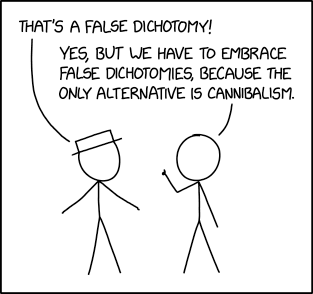Fallacies are common errors in reasoning that will undermine the logic of your argument. Fallacies can be either illegitimate arguments or irrelevant points, and are often identified because they lack evidence that supports their claim. Avoid these common fallacies in your own arguments and watch for them in the arguments of others.
Source: Purdue OWL
All of these print books and ebooks can be found at the CCC library or through the CCC library online catalog. If you need help finding or accessing these books (or any library books) please ask a librarian.
Learn how to search for books and ebooks in the CCC library catalog here.
These are just a few examples of common logical fallacies. There are many more than this. These examples came from Purdue OWL.
Purdue OWL.
"If we ban Hummers because they are bad for the environment eventually the government will ban all cars, so we should not ban Hummers."
In this example, the author is equating banning Hummers with banning all cars, which is not the same thing.
"We can either stop using cars or destroy the earth."
In this example, the two choices are presented as the only options, yet the author ignores a range of choices in between such as developing cleaner technology, car-sharing systems for necessities and emergencies, or better community planning to discourage daily driving.
"Even though it's only the first day, I can tell this is going to be a boring course."
In this example, the author is basing his evaluation of the entire course on only the first day, which is notoriously boring and full of housekeeping tasks for most courses. To make a fair and reasonable evaluation the author must attend not one but several classes, and possibly even examine the textbook, talk to the professor, or talk to others who have previously finished the course in order to have sufficient evidence to base a conclusion on.
"I drank bottled water and now I am sick, so the water must have made me sick."
In this example, the author assumes that if one event chronologically follows another the first event must have caused the second. But the illness could have been caused by the burrito the night before, a flu bug that had been working on the body for days, or a chemical spill across campus. There is no reason, without more evidence, to assume the water caused the person to be sick.
"George Bush is a good communicator because he speaks effectively."
In this example, the conclusion that Bush is a "good communicator" and the evidence used to prove it "he speaks effectively" are basically the same idea. Specific evidence such as using everyday language, breaking down complex problems, or illustrating his points with humorous stories would be needed to prove either half of the sentence.
"Green Peace's strategies aren't effective because they are all dirty, lazy hippies."
In this example, the author doesn't even name particular strategies Green Peace has suggested, much less evaluate those strategies on their merits. Instead, the author attacks the characters of the individuals in the group.
"People who don't support the proposed state minimum wage increase hate the poor."
In this example, the author attributes the worst possible motive to an opponent's position. In reality, however, the opposition probably has more complex and sympathetic arguments to support their point. By not addressing those arguments, the author is not treating the opposition with respect or refuting their position.
Comic is "False Dichotomy" by Randall Munroe